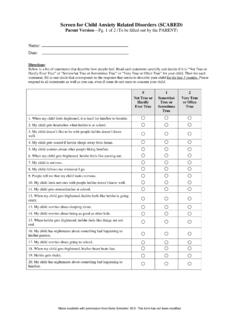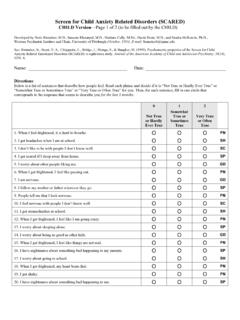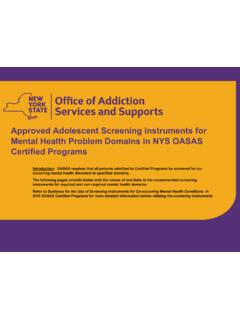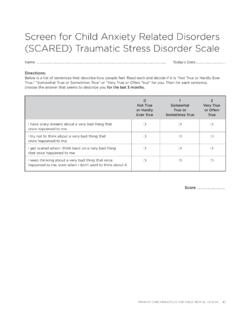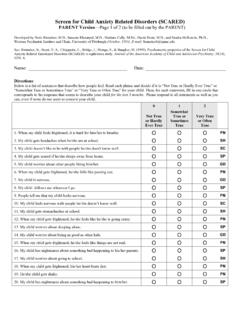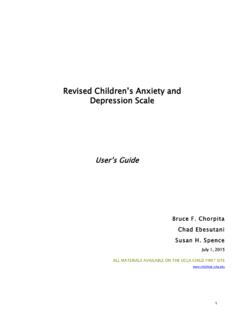Transcription of Objectives for Anxiety
1 7/2/20191 Applications of EBP and Psychiatric Medication Management for Anxiety By Dr. Margaret R. Emerson APRN, PMHNP-BCObjectives for Anxiety : Discuss EBP medications used in the management of Anxiety disorders in the primary care setting Describe appropriate use of benzodiazepines in primary care setting and EBP with this medication class Identify management strategies for benzodiazepine use in the primary care setting127/2/20192 Common Anxiety Generalized Anxiety Disorder (GAD) Social Anxiety Disorder Obsessive Compulsive Disorder (OCD) Panic Disorder Anxiety disorders in child /Adolescent Population Anxiety disorders affect about 15-20% of youth Anxiety disorders are among the most prevalent psychiatric conditions in the child and adolescent populations347/2/20193 Presentations in children School refusal Somatic symptoms GI symptoms Headaches Abdominal complaints.
2 Rituals Reassurance-seeking Agitation Aggression Insomnia/refusal to sleep alone PerfectionismNormal FearAsk yourself is this developmentally appropriate worry and fear?567/2/20194 Diagnostic Workup Medical workup Substance use Hyperthyroidism Hyperglycemia/Medical workup Seizure disorder Trauma screen MeasuresCurrent Practice RecommendationsThe American Academy of child & Adolescent Psychiatry [32] recommends: 1) Screening for Anxiety symptoms2) Rating the severity of the Anxiety symptoms3) Identifying functional impairment in youth with Anxiety disorders 4) Carefully assessing for co-morbid psychiatric conditions as well as for general medical conditions ( , hyperthyroidism) that may mimic Anxiety Tools Screening Tools for identification and progress tracking in patients >8 years of age.
3 Multidimensional Anxiety Scale for Children Screen for child Anxiety and related Emotional disorders (SCARED) Spence Children s Anxiety Scale (SCAS) The Preschool Anxiety ScaleParent report adapted from the SCAS Allows for screening for Anxiety in young children (ages to ). The Screen for Childhood and Anxiety related disorders (SCARED) (ages 8-11)Free Available online The Spence Children's Anxiety Scale (SCAS) (ages 8-15)Free Available online Clinician rated measure: Pediatric Anxiety Rating ScaleSpecific Phobias or Social Anxiety Tools: Social Anxiety ScaleSocial Worries Questionnaire,Social phobia subscale of SCAREDBest Practice for Treatment Multimodal.
4 1) education of the parents and the child about the Anxiety disorder2) consultation with school personnel and physician providers3) cognitive-behavioral interventions4) family therapy5) psychosocial stressors risk factors severity and impairment of the Anxiety disorder comorbid disorders age and developmental functioning of the child family functioning. attitudes or acceptance of a particular intervention provider-practitioner factors such as training, access to evidence-based interventions affordability9107/2/20196 When should you treat?When the Anxiety is causing functional impairments: Disruptions in social relationships/activities Disruptions in academic performance Disruptions IADLs Impact on peer and family relationships Attempts at self-medicationTreatment for child /Adolescent Anxiety Treatment Options: First Line: Parental psychoeducation Cognitive Behavioral Therapy (CBT) Second Line: Medication 11127/2/20197 Anxiety Medications Best supported by evidence POTS study (sertraline) CAMS study (sertraline)What did the POTs study tell us?
5 POTS CBT and sertraline were both superior to placebo CBT and sertraline combined showed the best efficacyRemission rates in order of effectiveness: 1.) Combined treatment2.) CBT3.) Sertraline4.) Placebo13147/2/20198 What did the CAMs study tell us? CAMS At 12 weeks: CBT > placebo Sertraline > placebo Combination > all Take home Individual CBT significantly reduced rates of Anxiety diagnoses when compared with controls CBT was equally effective or superior to comparison psychotherapies. Most effective: Combination of CBT and pharmacological management15167/2/20199 Pharmacologic Agents for Anxiety Specifically, psychopharmacologic trials data in pediatric patients with non-OCD Anxiety disorders suggest: SSRIs have emerged as the medication of choice in the treatment of childhood Anxiety disorders .
6 When Anxiety disorder symptoms are moderate or severe or impairment makes participation in psychotherapy difficult, or psychotherapy results in a partial response, treatment with medication is recommended Efficacy of benzodiazepines or buspirone in the treatment of youth with Anxiety disorders not : medications SSRI best evidentiary support. Considered first line medicationFDA approvals: Sertraline FDA approved for OCD ages 6 and up Fluoxetine FDA approved for OCD ages 7 and up* Fluvoxamine FDA approved for OCD ages 8 and up Escitalopram FDA approved for OCD ages 12 and upEvidence supports the efficacy of sertraline, citalopram, paroxetine, fluvoxamine, fluoxetine, and venlafaxine for treating children and adolescents with Anxiety disorders Cautions Agitation / black box warning Clinical Point.
7 When prescribing SSRIs for pediatric Anxiety , monitor patients for suicidality and routinely reassess suicide risk Sleep disturbance SNRI second line17187/2/201910 SSRI Side Effects Side Effects for SSRI s: Restlessness Jitteriness Headache Fatigue Dizziness Nausea Anorexia Weight gain. Sexual dysfunctions decreased libido impotence ejaculatory disturbances may be a problem in long-term treatmentFrom: FROM Considerations Discontinuation syndromes have been observed Overstimulation TimeFROM sSNRI s: Venlafaxine (in ages 6 and older) The findings of these trials were not sufficient to establish the efficacy of venlafaxine ER in treating GAD in pediatric patients according to FDA requirements, namely, 2 trials with statistically significant positive results on the primary outcome measure.
8 Dosing was weight based. Duloxetine FDA approved for GAD For children 7 and older Initially, 30 mg PO once daily for 2 weeks. Thereafter, an increase to 60 mg/day PO may be considered. The recommended range is 30 to 60 mg PO once daily; however, some patients may benefit from doses higher than 60 mg/day PO. If doses higher than 60 mg/day PO are used, the increase should occur in increments of 30 mg/day PO. Max: 120 mg/day. In 1 clinical trial, the mean dose for patients completing the 10-week treatment phase was mg/day.[29934]From: Anxiety 21227/2/201912 Adult Anxiety Duloxetine: Indication: Generalized Anxiety Disorder Starting dose 30 mg.
9 Increase dose by 30 mg per day. Max dose 120 mg by mouth dailyEscitalopram: indication: GADS tarting dose 10 mg by mouth dailyMax dose 20 mg by mouth dailyFluoxetine:Indication panic disorder, OCDS tarting dose 10 mg by mouth dailyMax dose 60 mg per dayFluvoxamine: Indication OCDS tarting dose 50 mg by mouth at bedtimeMax dose 300 mg. Doses above 100 mg to be given in 2 divided doses Adult Anxiety Paroxetine:Indication GAD, OCD, social Anxiety disorder, panic disorder, PTSDS tarting dose to 10 mg by mouth dailyTypically increased by 10 mg by mouth weeklyMax dose 50-60 mg by mouth daily depending on indicationSertraline.
10 Indication OCD, panic disorder, PTSD, social Anxiety disorderStarting dose typically 25-50 mg by mouth dailyAllow at least a week between dose increasesMax dose 200mg by mouth daily Venlafaxine ERIndication generalized Anxiety disorder, panic disorder, social Anxiety disorderStarting dose mg by mouth dailyCan increase typically after 7 daysMax dose 225 mg by mouth daily with the exception of social Anxiety disorder. With Social Anxiety Disorder there is no evidence that doses above 75 mg provide additional Measures Hamilton Anxiety Rating Scale (HAM-)14 items Clinician rating scaleAvailable in public domain Generalized Anxiety Disorder 7 Item Scale (GAD-7)7 itemsPatient reportAvailable for use in public domain and commonly used in primary care settingsFrom: Spitzer, Robert L.


